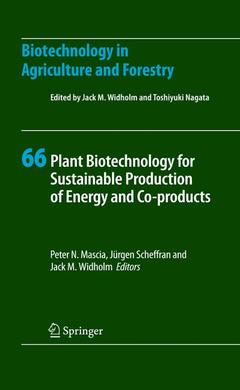Description
Plant Biotechnology for Sustainable Production of Energy and Co-products, 2010
Biotechnology in Agriculture and Forestry Series, Vol. 66
Coordinators: Mascia Peter N., Scheffran Jürgen, Widholm Jack M.
Language: English
Subjects for Plant Biotechnology for Sustainable Production of Energy...:
Plant Biotechnology for Sustainable Production of Energy and Co-products
Publication date: 11-2012
458 p. · 15.5x23.5 cm · Paperback
Publication date: 11-2012
458 p. · 15.5x23.5 cm · Paperback
Plant Biotechnology for Sustainable Production of Energy and Co-products
Publication date: 09-2010
458 p. · 15.5x23.5 cm · Hardback
Publication date: 09-2010
458 p. · 15.5x23.5 cm · Hardback
Description
/li>Contents
/li>Comment
/li>
This book is a collection of chapters concerning the use of biomass for the sustainable production of energy and chemicals?an important goal that will help decrease the production of greenhouse gases to help mitigate global warming, provide energy security in the face of dwindling petroleum reserves, improve balance of payment problems and spur local economic development. Clearly there are ways to save energy that need to be encouraged more. These include more use of energy sources such as, among others, manure in anaerobic digesters, waste wood in forests as fuel or feedstock for cellulosic ethanol, and conservation reserve program (CRP) land crops that are presently unused in the US. The use of biofuels is not new; Rudolf Diesel used peanut oil as fuel in the ?rst engines he developed (Chap. 8), and ethanol was used in the early 1900s in the US as automobile fuel [Songstad et al. (2009) Historical perspective of biofuels: learning from the past to rediscover the future. In Vitro Cell Dev Biol Plant 45:189?192). Brazil now produces enough sugar cane ethanol to make up about 50% of its transportation fuel needs (Chap. 4). The next big thing will be cellulosic ethanol. At present, there is also the use of Miscanthus x giganteous as fuel for power plants in the UK (Chap. 2), bagasse (sugar cane waste) to power sugar cane mills (Chap. 4), and waste wood and sawdust to power sawmills (Chap. 7).
to Biofuels.- Overview: World Energy Resources and the Need for Biomass for Energy and Lower Fossil Carbon Dioxide Emissions.- Designing Biomass Crops with Improved Calorific Content and Attributes for Burning: a UK Perspective.- Designing Plants To Meet Feedstock Needs.- Specific Biofuel Feedstocks.- Engineering Advantages, Challenges and Status of Sugarcane and other Sugar-Based Biomass Resources.- High Fermentable Corn Hybrids for the Dry-Grind Corn Ethanol Industry.- Engineering Advantages, Challenges and Status of Grass Energy Crops.- Woody Biomass and Purpose-Grown Trees as Feedstocks for Renewable Energy.- Engineering Status, Challenges and Advantages of Oil Crops.- Mitigating Invasiveness.- Invasive Species Biology, Ecology, Management and Risk Assessment: Evaluating and Mitigating the Invasion Risk of Biofuel Crops.- Gene Flow in Genetically Engineered Perennial Grasses: Lessons for Modification of Dedicated Bioenergy Crops.- Genetic Modification in Dedicated Bioenergy Crops and Strategies for Gene Confinement.- Models for Uses of Biomass Feedstocks.- Integrated Biorefineries—A Bottom-Up Approach to Biomass Fractionation.- Heat and Power Production from Stover for Corn Ethanol Plants.- Agricultural Fit of Biomass Crops and Lifecycle Analysis and Criteria.- The Problem is the Solution: the Role of Biofuels in the Transition to a Regenerative Agriculture.- Life-Cycle Analysis of Biofuels.- Criteria for a Sustainable Bioenergy Infrastructure and Lifecycle.
Discusses the possible uses of plant biomass
Covers cutting-edge research and development
Written by top scientists
Includes supplementary material: sn.pub/extras
© 2024 LAVOISIER S.A.S.




